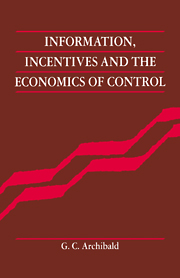Book contents
- Frontmatter
- Contents
- Preface
- Part I Introductory
- Part II Iterative controls
- 3 Feed-back control processes
- 4 First example: an externality problem
- 5 Second application of the control process: Lerner's Problem
- 6 Third example of the control process: implementation of a second-best solution
- 7 Two examples of the control process in a mixed economy
- Part III Non-convexities
- Part IV Cooperatives
- Appendix: The taxation of economic rent
- Notes
- Bibliography
- Index
7 - Two examples of the control process in a mixed economy
Published online by Cambridge University Press: 19 October 2009
- Frontmatter
- Contents
- Preface
- Part I Introductory
- Part II Iterative controls
- 3 Feed-back control processes
- 4 First example: an externality problem
- 5 Second application of the control process: Lerner's Problem
- 6 Third example of the control process: implementation of a second-best solution
- 7 Two examples of the control process in a mixed economy
- Part III Non-convexities
- Part IV Cooperatives
- Appendix: The taxation of economic rent
- Notes
- Bibliography
- Index
Summary
The class of problems considered
The purpose of ch. 7 is to illustrate two further uses of step-wise controls. Other examples might have been chosen. Thus an iterative control may be used to force a profit-maximizing multiproduct firm to Ramsay prices (see Finnsinger and Vogelsang, 1979). Ramsay prices themselves may require some justification, but after our consideration of the Rule may be thought of as at least having some plausible rationality. The iterative scheme proposed by Finnsinger and Vogelsang is, of course, informationally decentralized in the sense discussed in ch. 3; we need no information which is not obtained easily during the process. We have the usual trade-off between the possibilities of overshoot (lack of monotonicity) and strategic behavior.
Another attractive, but probably frustrating, example comes to mind: application to the control of a common-property, open-access, renewable resource such as a fishery. The target is obviously rent. Without control, open access ensures that this is dissipated in over-fishing. Most methods of control depend on constructing expensive, and usually unreliable, models of the fish population, and imposing quotas, restricting fishing methods, or both, incurring further resource cost, both for enforcement and for the required fishing methods (to say nothing of the problems of international agreement and enforcement on the high seas). Rent is then dissipated in all directions: it is certainly not collected. It would seem easy and natural to impose a tax on fish landed, and to endow the tax clerk with a simple little algorithm by which to adjust the rate until its yield was maximized.
- Type
- Chapter
- Information
- Information, Incentives and the Economics of Control , pp. 79 - 88Publisher: Cambridge University PressPrint publication year: 1992

